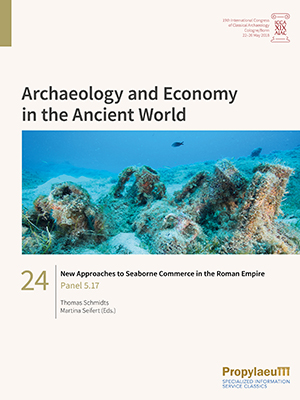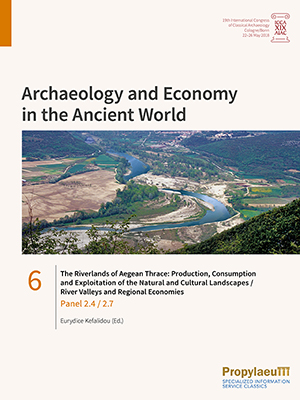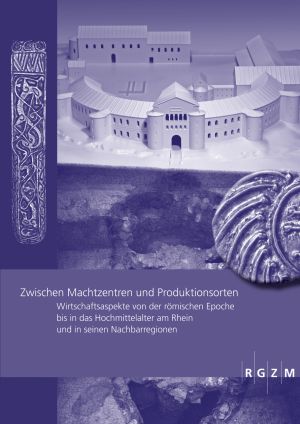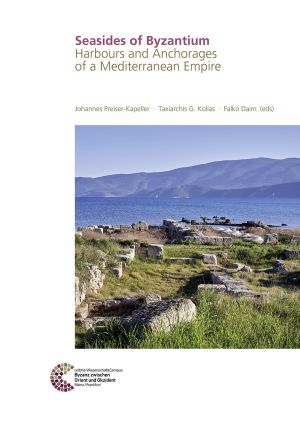Schmidts, Thomas
New Approaches to Seaborne Commerce in the Roman Empire: Panel 5.17
Seaborne commerce in the Roman Empire is characterised by a remarkable efficiency for the pre-modern world. From Egypt to Britain, trade connections can be proven on the basis of archaeological finds. The range of these activities includes the Mediterranean, the Black Sea and parts of the north-eastern Atlantic. Important reference points for the assessment of Roman merchant shipping are ports, ships and cargo remains. Due to the large number of known shipwrecks and ports, archaeology in particular can contribute to a better understanding of maritime trade.
The contributions address various aspects of the "seaborne commerce" with a broad methodological spectrum. In addition to wreck finds, the relevance of inscriptions on amphorae and other cargo remains are considered as well as the formation of networks, the reconstruction of ship routes and the performance of ancient watercraft based on experiments.
Mare Thracium: Archaeology and History of Coastal Landscapes and Islands of the Thracian Sea during Antiquity and the Byzantine Era. International Workshop within the Framework of the DFG Project »The Thracian harbour city Ainos in Roman and Byzantine times – the development of a traffic hub in a changing environment«
Despite its peripheral location, the Mare Thracium was an integral part of the Mediterranean world. The wealth of its resources and the rivers connecting to the Thracian hinterland were of great importance. Numerous harbour cities contributed significantly to the development of the region from the Archaic to the Byzantine period and even beyond.
The contributions in this volume originated from a workshop held in Mainz in 2016 as part of the DFG Priority Programme (SPP 1630) »Harbours from the Roman Period to the Middle Ages«. They deal with the natural conditions for seafaring, historical developments, the physical remains of coastal settlements and their harbours, and underwater finds.
Schiffe und ihr Kontext: Darstellungen, Modelle, Bestandteile – von der Bronzezeit bis zum Ende des Byzantinischen Reiches
Seafaring was extraordinary important in Antiquity and the Middle Ages for the economy and the wielding of power. It also provided contact between distant places. Ships were on the one hand decorated and ornamented and on the other hand they were frequently objects of depictions which could range from sketchy graffiti to three-dimensional reproductions. The contexts of the depictions encompass different areas, such as public and private representation as well as religion.
This Volume assembles 18 articles that have been presented on the occasion of an international workshop in 2013. Different groups of material ranging from the period of Bronze Age until the end of the Byzantine Empire were presented as well as the development of ship-building and navigation. The depictions of ships which have investigated scanty until now were the main target of the workshop.
The Riverlands of Aegean Thrace: Production, Consumption and Exploitation of the Natural and Cultural Landscapes | River Valleys and Regional Economies: Panel 2.4 | Panel 2.7
Rivers have always been vital supports for economies. They provided water for people and animals, irrigated the land, facilitated communication and trade through small vessels or rafts, aided industrial activities, formed rich hunting grounds for fishermen and hunters, and offered raw materials such as sand, gravel and placer deposits - including even gold. At the same time, the deltas and marshlands of rivers, created an inhospitable environment unsuitable for habitation, especially in periods of flood. Furthermore, rivers connected the sea and the littoral zone with the hinterland, and thus allowed the interaction between the populations which inhabited these areas, often locals and colonists/merchants.
The papers address topics such as the reconfiguration of ancient river routes, the settlement and exploitation patterns that were formed around them, the boundaries of the chora of various cities, towns, villages and farmsteads, and the communication or the tensions between different groups that moved or expanded beyond their original habitation zone due to environmental and/or economic reasons.
Panels 2.4 and 2.7 explore multiple facets of some Central and Eastern Mediterranean riverlands. Panel 2.4 investigates Aegean Thrace, i.e. the Northeastern part of Greece and the European part of Turkey. Panel 2.7 looks at three river valleys in two different areas: Athens and Attica with the Ilissos River; and Northeastern Italy with the rivers that flow in the areas of Verona and Parma.
Zwischen Machtzentren und Produktionsorten: Wirtschaftsaspekte von der römischen Epoche bis in das Hochmittelalter am Rhein und in seinen Nachbarregionen
On 12 November 2018, a cooperation agreement was signed in Ingelheim am Rhein between the Kaiserpfalz Research Centre based there and the Roman-Germanic Central Museum, Leibniz Research Institute for Archaeology. With this agreement, the close ties that have existed since the middle of the 19th century between the scientists in Mainz and the researchers of the Imperial Palace in Ingelheim were confirmed in writing. The future cooperation will focus particularly on European economic aspects and topics of supra-regional materials research. The first fruits of this cooperation were presented at interdisciplinary conferences on 12 and 13 November 2018 in Ingelheim and on 28 and 29 November 2019 in Mayen. These events also served as an intensive exchange with scientists from Germany and abroad. The results of both conferences are brought together in this conference volume. In 25 papers, the fundamentals of trade in the Rhineland and its neighbouring regions as well as the processes of the exchange of goods between centres of power, rural regions and production sites in the period from the Roman era to the High Middle Ages are examined from very different perspectives. Both for the large-scale development tendencies and the relationships between different economic regions as well as for the production sites and the marketing routes, the contributions offer trend-setting explanations, fundamental presentations and exceptional descriptions. They form the basis for future research in parts of Europe adjacent to the Rhineland, which is planned within the framework of the cooperation and will be reflected in further conferences.
Seasides of Byzantium: Harbours and Anchorages of a Mediterranean Empire
In recent years, interest in the study of maritime installations and networks in the Roman and Byzantine Mediterranean has increased considerably, as documented by various projects and publications.
The conference »Seasides of Byzantium. Harbours and Anchorages of a Mediterranean Empire«, from which the papers collected in the present volume emerged, took place in Athens in 2017 as part of a cooperation between the DFG-funded Special Research Programme (SPP 1630) »Harbours from the Roman Period to the Middle Ages« and the National Hellenic Research Foundation. It united historians, archaeologists and geoarchaeologists to explore harbours and anchorages as core maritime infrastructure to the Late Roman and Byzantine Empire.
General phenomena such as the organisation of the Byzantine navy and its operations or lighthouses are discussed in this volume as well as new geoarchaeological research methodologies in harbour archaeology. Most contributions in the present volume examine case studies for the most important maritime core region of the Byzantine Empire, the Aegean. This sea connected the remaining provinces of the empire in Southeastern Europe and Asia Minor after the loss of Syria, Palestine, Egypt, and North Africa to the Arabs in the 7th century AD. In addition to technical and geographical aspect, the studies in this volume make clear that we need to explore more and more the social embedding of the seasides of Byzantium to understand their dynamics in all their complexity.












